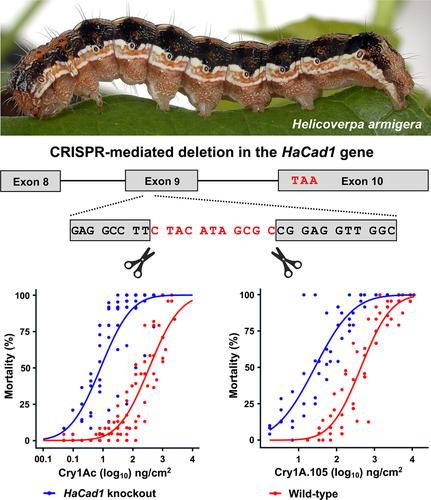当前位置:
X-MOL 学术
›
Pest Manag. Sci.
›
论文详情
Our official English website, www.x-mol.net, welcomes your
feedback! (Note: you will need to create a separate account there.)
Cry1 resistance in a CRISPR/Cas9‐mediated HaCad1 gene knockout strain of the Australian cotton bollworm Helicoverpa armigera conferta (Lepidoptera: Noctuidae)
Pest Management Science ( IF 3.8 ) Pub Date : 2024-11-15 , DOI: 10.1002/ps.8500 Cao (Grace) Fang, Bill James, Michelle Williams, Andy Bachler, Wee Tek Tay, Tom Walsh, Michael Frese
Pest Management Science ( IF 3.8 ) Pub Date : 2024-11-15 , DOI: 10.1002/ps.8500 Cao (Grace) Fang, Bill James, Michelle Williams, Andy Bachler, Wee Tek Tay, Tom Walsh, Michael Frese

|
BACKGROUNDHelicoverpa armigera is a highly polyphagous species that causes huge losses to agricultural and horticultural crops worldwide. In the cotton industry, H. armigera, including the Australian subspecies Helicoverpa armigera conferta , is largely managed using genetically modified crops that express insecticidal toxins, such as Cry1Ac. Resistance to Cry1 proteins occurs and, in some cases, is mediated by changes to HaCad1 , a gene that encodes the midgut protein cadherin. Around the world, numerous resistance‐associated polymorphisms have been identified in the HaCad1 gene of H. armigera , but Cry1Ac resistance is rare in the Australian subspecies. We used CRISPR/Cas9 to disrupt the cadherin gene in H. armigera conferta and characterised the resulting phenotype with bioassays and transcriptomics.RESULTSCompared to the parental strain, the newly generated HaCad1 knockout strain is 44‐fold and 16‐fold more resistant to Cry1Ac and Cry1A.105, respectively, while wild‐type and knockout insects were equally insensitive to Cry1F.CONCLUSIONThe disruption of the HaCad1 gene causes Cry1Ac resistance in Australian H. armigera conferta . However, Cry1Ac resistance remains rare in Australian field populations suggesting that Australia's approach to pest management in cotton has prevented widespread Cry1Ac resistance. © 2024 CSIRO. Pest Management Science published by John Wiley & Sons Ltd on behalf of Society of Chemical Industry.
中文翻译:

澳大利亚棉铃虫 Helicoverpa armigera conferta(鳞翅目:夜蛾科)的 CRISPR/Cas9 介导的 HaCad1 基因敲除菌株中的 Cry1 抗性
背景棉铃是一种高度多食性物种,对全世界的农业和园艺作物造成巨大损失。在棉花工业中,棉铃草,包括澳大利亚亚种 Helicoverpa armigera conferta,主要使用表达杀虫毒素的转基因作物进行管理,例如 Cry1Ac。对 Cry1 蛋白的耐药性发生,在某些情况下,是由 HaCad1 的变化介导的,HaCad1 是编码中肠蛋白钙粘蛋白的基因。在世界各地,已在棉铃嗜血杆菌的 HaCad1 基因中鉴定出许多与抗性相关的多态性,但 Cry1Ac 抗性在澳大利亚亚种中很少见。我们使用 CRISPR/Cas9 破坏棉铃草中的钙粘蛋白基因,并通过生物测定和转录组学表征所得表型。结果与亲本菌株相比,新产生的 HaCad1 敲除菌株对 Cry1Ac 和 Cry1A.105 的抗性分别高 44 倍和 16 倍,而野生型和敲除昆虫对 Cry1F 同样不敏感。然而,Cry1Ac 耐药性在澳大利亚田间种群中仍然很少见,这表明澳大利亚对棉花的害虫管理方法阻止了广泛的 Cry1Ac 耐药性。© 2024 年 CSIRO。由John Wiley & Sons Ltd代表化学工业协会出版的《害虫管理科学》。
更新日期:2024-11-15
中文翻译:

澳大利亚棉铃虫 Helicoverpa armigera conferta(鳞翅目:夜蛾科)的 CRISPR/Cas9 介导的 HaCad1 基因敲除菌株中的 Cry1 抗性
背景棉铃是一种高度多食性物种,对全世界的农业和园艺作物造成巨大损失。在棉花工业中,棉铃草,包括澳大利亚亚种 Helicoverpa armigera conferta,主要使用表达杀虫毒素的转基因作物进行管理,例如 Cry1Ac。对 Cry1 蛋白的耐药性发生,在某些情况下,是由 HaCad1 的变化介导的,HaCad1 是编码中肠蛋白钙粘蛋白的基因。在世界各地,已在棉铃嗜血杆菌的 HaCad1 基因中鉴定出许多与抗性相关的多态性,但 Cry1Ac 抗性在澳大利亚亚种中很少见。我们使用 CRISPR/Cas9 破坏棉铃草中的钙粘蛋白基因,并通过生物测定和转录组学表征所得表型。结果与亲本菌株相比,新产生的 HaCad1 敲除菌株对 Cry1Ac 和 Cry1A.105 的抗性分别高 44 倍和 16 倍,而野生型和敲除昆虫对 Cry1F 同样不敏感。然而,Cry1Ac 耐药性在澳大利亚田间种群中仍然很少见,这表明澳大利亚对棉花的害虫管理方法阻止了广泛的 Cry1Ac 耐药性。© 2024 年 CSIRO。由John Wiley & Sons Ltd代表化学工业协会出版的《害虫管理科学》。


















































 京公网安备 11010802027423号
京公网安备 11010802027423号